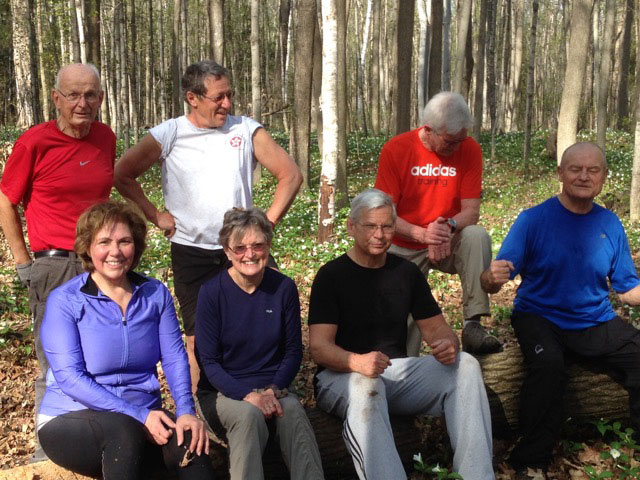
Farmhand Fitness Among the Trilliums
Thank you for the great article “Sample Class: Farmhand Fitness,” by
Ryan Halvorson [Class Take-Out, April 2015]. I have a group of older
adults (mean age 70) who train outdoors near Montreal, doing boot
camp–style classes in summer and snowshoeing in winter.
For 2 weeks in the spring, before the black flies and mosquitoes come
out, we do this “farmhand” type of class among the trillium wildflowers.
We have hammered, axed, sledgehammered, sawed a log, thrown SandBells®
(like the bales of hay in the article), climbed over trees and slithered
through tires.
Gay Elliott
Longtime IDEA member and past
presenter
Hudson, Quebec
What Food
Tribe Do You Follow?
I have been a vegetarian for about 20 years—the last 9 of them as a
vegan. I do not consider this a “diet” but, rather, a lifestyle. Vegan
is how I relate to the world. It is much more than what I put in my
mouth.
The path to a vegan lifestyle has actually been the result of many
aspects drawing into one center, many parts of a puzzle fitting in. I
grew up loving and respecting animals and plants. I became what I would
call an environmentalist during middle school. In the early ’80s, before
I became a vegetarian, I had an allergist who encouraged me to drop food
additives, hormones and antibiotics from my diet. Next, I lost the red
meat. I began to see that the vegetarian and vegan way of eating fit in
with my concerns for wellness, the environment and compassion toward
animals. Is this a sustainable diet? Reputable records of vegetarians
date back to the 5th and 6th centuries. I believe it is the “diet” that
gives the earth the most hope of being sustained.
Also, kudos to IDEA Fitness Journal on behalf of the American
Music Therapy Association for including mentions of music therapy as an
effective therapeutic intervention. I have seen mentions in the
Mind-Body-Spirit News section in the last two issues!
Ruth Sahuc Mannich
Personal Trainer
Pooler, Georgia
Promoting Mind-Body
Personal Training
I recently started a 10-session small-group training class (3–6 people)
called Mind/Body Energy at the Greystone YMCA in Birmingham, Alabama.
The format is designed to increase awareness of the mind-body connection
in a personal training setting.
We begin with myofascial release using foam rollers or tennis balls,
followed by a yoga-based, dynamic warm-up. During the work phase, we
incorporate the use of stability balls, foam rollers, tubing and light
weights to work each major muscle group. Balance exercises are performed
while standing, supine and prone, utilizing the equipment mentioned
above. We cool down with stretches and deep breathing, which brings
awareness to areas that may be less flexible.
We have advertised the class on our group fitness Facebook page and with
posters placed throughout the facility. This format seems to appeal to
our mature members looking for more individualized attention than they
might receive in a large group class. As an instructor and trainer, I
enjoy the opportunity to be creative and to focus on each member of the
group.
Sandra Gosselin Fleury
Personal Trainer
Birmingham, Alabama
Enhance Your Cuing
and Communication
The feature “Attentional Focus & Cuing,” by Nick Winkelman, MS [May
2015], captures an aspect of training (external and internal focus)
that’s very useful. I would like to suggest some additions to the
sidebar “Understanding the Language of Movement.” Based on my
experience, the following enhance client communication:
- Mention what body part initiates the movement.
- Ask for correct breathing to support the movement.
- Indicate exactly where that body part is going in the space.
Only after the trainer sees a movement trial(s) should she give feedback
and adjustments. The movement itself will tell the trainer what to
correct.
Here’s an example of these instructions used for a bench press. The
client is in position on the bench:
- “Lead with your knuckles.”
-
“Take a breath before you start the movement, and exhale throughout
the elbow extension.” - “Smoothly press your hands forward (toward the ceiling).”
The direction vocabulary will vary depending on whether it’s a spatial
reference or a body reference.
Dianne L. Woodruff, PhD
Certified Movement Analyst
Oakville, Ontario
Empathy for Clients
Reaps Rewards
Thank you for the article “How to Be an Empathetic Personal Trainer,” by
Ryan Halvorson [Client Success, June 2015]. It is wonderful to see
stories like this in a fitness publication. So often our industry
focuses on the super athlete when our special populations also need our
services.
After 10 years of teaching Pilates (I co-own and operate a studio), I
was asked by a woman from my church if I would be willing to work with
her husband, who is 90 years old and blind. Well, I think I have learned
more from George than he has learned from me. What an inspiration. He is
a great example of tenacity. He was hospitalized for pneumonia but
returned to Pilates. I called him and told him that was one heck of a
way to get out of training!
Martha Laubacher
Co-owner, Kinematics Corps
La Grange, Illinois
Erratum
Our answer key for July–August CEC Quiz 5 (“Comparing Suspension
Exercise to Traditional Resistance Methods,” pp. 133–34) originally
indicated an incorrect response for Question #9. The correct answer to
this question is “A,” not “B,” and was changed immediately; however, in
the spirit of fairness to all, everyone who takes this quiz will get the
answer credited to them. n
“We do this ‘farmhand’ type of class among the trillium wildflowers. We
have hammered, axed, sledgehammered, sawed a log, thrown SandBells®
(like the bales of hay in the article), climbed over trees and slithered
through tires.”
—Gay Elliott